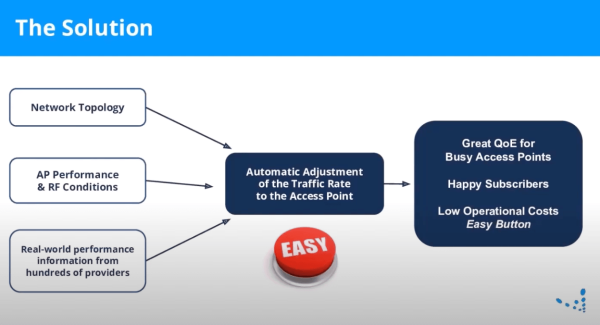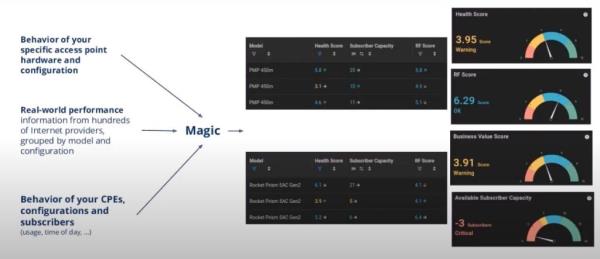29 October 2025
Neil McDonald, Preseem
Based on their frequency in the calls we have with regional ISPs every day, the top four most common issues are:
- Network congestion and capacity management
- Poor individual connection quality
- Improving support efficiency and troubleshooting accuracy
- Reactive vs. proactive network management
1. Network Congestion and Capacity Management
This is the most frequently discussed issue, appearing in nearly every operational call. The core problem is that access points (APs) become overloaded, leading to insufficient airtime for subscribers.
Symptoms: During peak usage hours, there is no available airtime on an AP, which causes high latency, buffering, and an inability for customers to use their purchased plan speeds. On customer APs, this often appears as a “Low TX Airtime” or “Oversubscribed” diagnostic flag.
Business Impact: This directly leads to a poor customer experience for everyone connected to the sector, making it a primary driver of support calls and customer churn. As one participant noted, even customers with perfect installations will have a bad experience if the AP is the bottleneck.
Solutions Discussed: Teams frequently talk about applying AP shapers as a band-aid solution, load-balancing heavy users to other sectors, and upgrading hardware or splitting sectors as a long-term fix.
How Preseem Helps
Delivering a consistently good subscriber experience requires actively managing network congestion. The first step is proactively managing the network’s capacity to meet subscriber demands. Unlike reactive approaches from alternatives that require AP rates to be manually configured and that don’t scale due to dynamically changing RF and subscriber behaviours, Preseem’s Access Point and CPE Radio scores greatly simplify this task, require little RF expertise, and work across access point manufacturers.
Best of all, our Automatic Access Point Capacity Management capability is vendor- and application-neutral. No artificial limits on specific applications are required, and fair bandwidth allocation between subscribers on an Access Point is achieved in real time.

2. Poor Individual Connection Quality (RF Health)
The second most common problem is the poor quality of an individual customer’s wireless connection to the access point. This can be caused by a number of factors and often requires a site visit to resolve.
Symptoms: The direct causes are often very poor received signal strength indicator (RSSI), high interference, or a link rate that is too unstable or low to support the customer’s subscribed plan. This was the case for an ISP’s subscriber who was paying for a 50 Mbps plan but whose connection could never achieve it.
Business Impact: A single customer with a very poor connection can consume a disproportionate amount of AP airtime, degrading the experience for all other users on that sector. This also leads to direct customer complaints, as seen with another customer who needed a truck roll to fix an RSSI of -85 dBm.
Solutions Discussed: The solutions typically involve dispatching a technician to realign the radio, investigate sources of interference (like a Wi-Fi extender placed too close to the router), or check for physical issues like bad cables.
How Preseem Helps
Preseem identifies these issues as a low RF Score. The RF Score shows the RF condition of an AP based on CPE Radio link rates and stability throughout the day. This enables operators to identify APs with poor RF conditions across many dimensions with a single, sortable score that can be used to prioritize proactive network improvements. This score also reduces the expertise required to identify APs with poor RF and makes existing RF experts more efficient. This means they can spend more time fixing problems instead of looking for them. Here’s a look at how some of our scores get made, with a sprinkling of Preseem “magic,” of course.

3. Improving Support Efficiency and Troubleshooting Accuracy
The previous two problems relate specifically to fixed wireless providers. Another common challenge for both fixed wireless and fiber operators, however, is enabling support teams to quickly and accurately diagnose the root cause of customer issues, which would reduce costly escalations and truck rolls.
Staff Training: Representatives from numerous ISPs said their support staff need better training on network tools to interpret data correctly and troubleshoot effectively.
Root Cause Analysis: A common theme is the difficulty in determining if a customer’s problem originates from in-home Wi-Fi, the customer’s equipment (CPE), a congested AP, or an upstream backhaul issue.
Tool Sprawl: Support teams often have to use multiple, disconnected systems to get a full picture of a customer’s situation. The need for a “single pane of glass” to streamline the troubleshooting process is a recurring point.
How Preseem Helps
Preseem makes complex issues easy to understand with scores and metrics that help your support team improve their expertise and resolve tickets faster. Preseem provides one platform with dozens of vendor integrations and a global search across your entire access network and subscribers. This way, you can extract information from all network elements and isolate the root cause of issues faster. No more staring and comparing across multiple systems!
Customer quote: "Prior to having Preseem in our network, speed control was a nightmare, and customers were always complaining of slow internet speeds. After Preseem was put in, those complaints have dropped to almost none. Preseem also gives us good tools to use to diagnose network issues and usage habits. It is a vital part of our network," said Steve Barnes, Cybersecurity Manager, New Lisbon Broadband and Communications.
4. Reactive vs. Proactive Network Management
A core operational challenge mentioned across multiple companies is the struggle to move from a reactive “firefighting” model to a proactive one.
Symptoms: Teams find themselves only analyzing the network when a customer calls in with a complaint. This means they’re often unaware of systemic issues until they’ve already impacted subscribers. One ISP noted they had to rely entirely on customer feedback to know if a fix worked because they lacked proactive tools.
Business Impact: This operational model leads to higher churn, as customers who don’t call in may suffer in silence with a poor experience before switching providers. It also creates inefficiency, as support teams spend time troubleshooting individual complaints that are symptoms of a larger, unaddressed network bottleneck.
How Preseem Helps
Instead of just reacting to network problems, Preseem helps you get ahead of them. Our proactive insights show you where Quality of Experience (QoE) is trending down, allowing you to pinpoint potential issues and make improvements before they impact your customers. This helps you prevent support calls and seize opportunities for growth.







